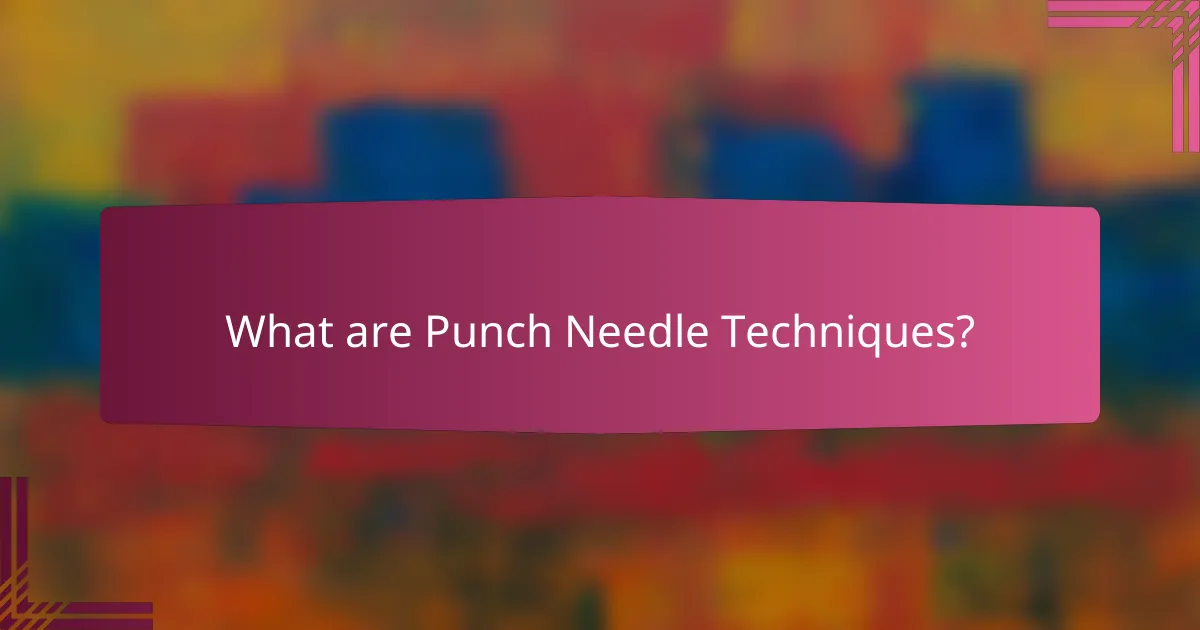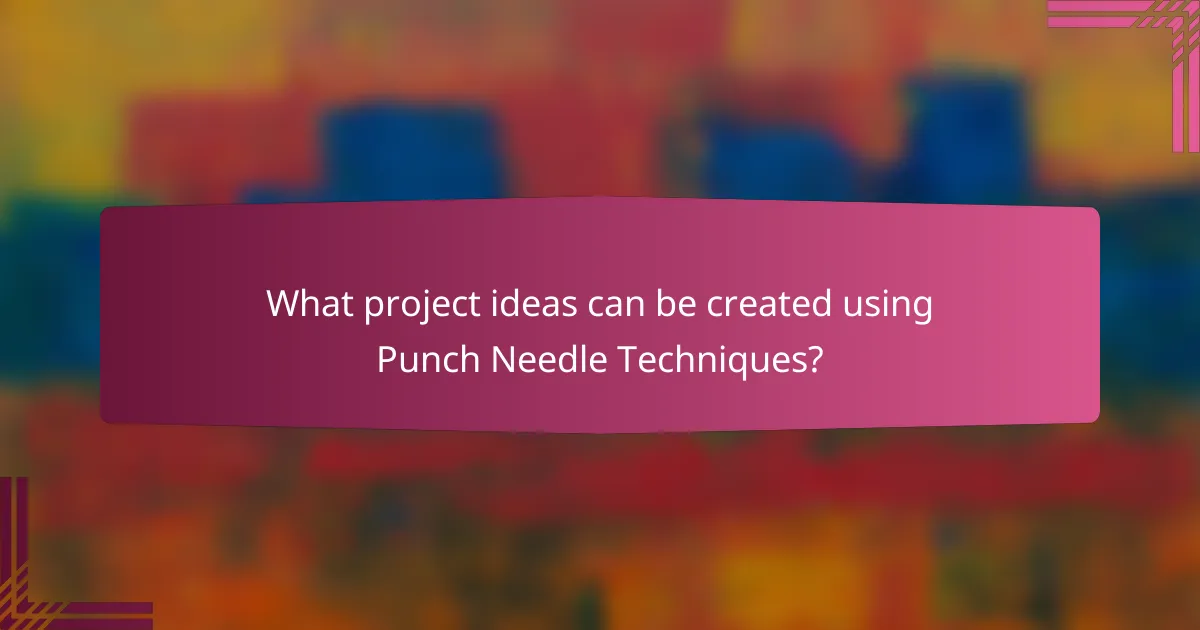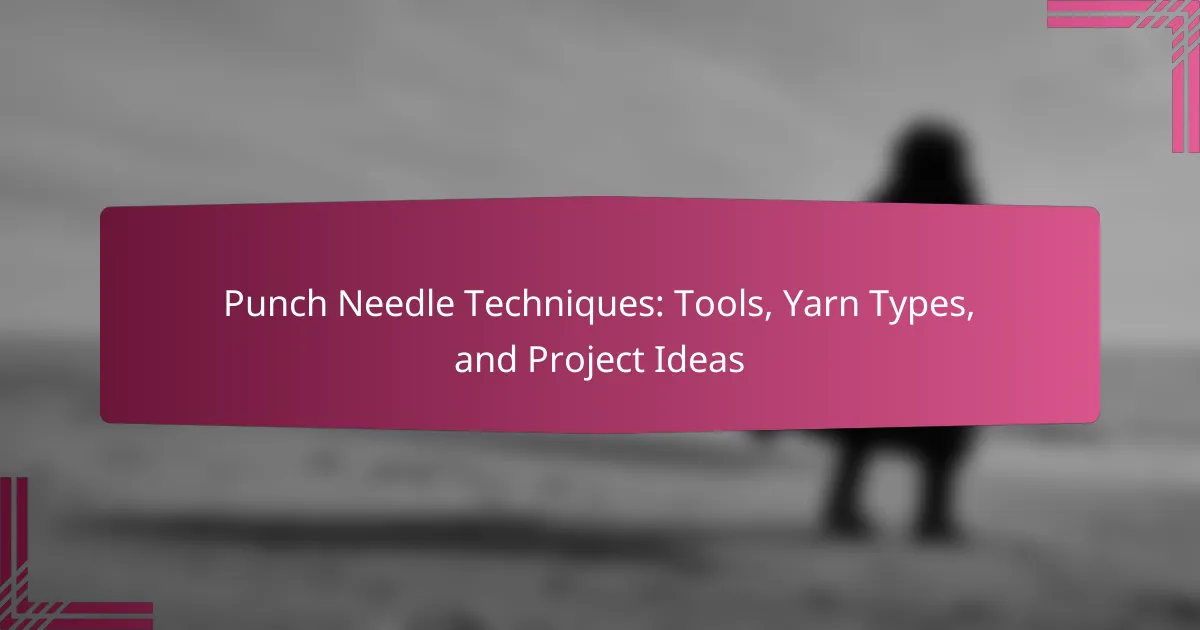
What are Punch Needle Techniques?
Punch needle techniques involve using a specialized tool to create fabric art by punching yarn through a base material. This method allows for the creation of textured designs and patterns. The punch needle tool has a hollow shaft that guides the yarn through the fabric. As the tool is pushed through, it creates a loop on the surface. Different techniques can produce varying textures and effects. Common techniques include loops of different heights and varying yarn tension. Mastery of these techniques can enhance the quality and creativity of the finished piece. Punch needle art has roots in traditional crafts and has gained popularity in modern textile art.
How do Punch Needle Techniques differ from other textile arts?
Punch needle techniques differ from other textile arts primarily in their method of creating fabric. Unlike weaving or knitting, punch needle involves a specialized tool that punches yarn through a backing material. This technique allows for quick creation of textured designs. The punch needle tool creates loops on the surface, which can vary in height for different effects. Other textile arts often require more complex processes, such as multiple steps in weaving or intricate stitch patterns in knitting. Additionally, punch needle is generally more accessible for beginners due to its straightforward technique. It has gained popularity for its ability to produce vibrant, tactile pieces efficiently.
What are the fundamental principles behind Punch Needle Techniques?
Punch needle techniques are based on the principles of creating textured fabric through a looping method. This method involves using a specialized punch needle tool to insert yarn into a backing material. The yarn is pushed through the fabric, forming loops on one side while remaining anchored on the other.
The technique allows for various patterns and designs to be created, depending on the yarn type and tension used. The punch needle can vary in size, affecting the loop size and texture.
Additionally, the choice of backing material influences the final appearance and durability of the project. Common materials include burlap and linen, known for their sturdiness.
Punch needle techniques have roots in traditional embroidery practices, making them both historical and contemporary crafts. This method has gained popularity for its ease of use and creative potential.
What skills are essential for mastering Punch Needle Techniques?
Essential skills for mastering punch needle techniques include precision, patience, and creativity. Precision is crucial for accurate stitching and maintaining consistent tension. Patience allows for the meticulous work required in creating detailed designs. Creativity enables the artist to envision and execute unique patterns and color combinations. Additionally, understanding yarn types and their properties enhances the quality of the finished piece. Familiarity with tools, such as different needle sizes and fabric types, is also important for achieving desired results. Mastery of these skills leads to successful punch needle projects.
What tools are necessary for Punch Needle Techniques?
The necessary tools for Punch Needle Techniques include a punch needle, fabric, and yarn. A punch needle is specifically designed for creating loops in fabric. The fabric should be sturdy, such as monk’s cloth or burlap, to hold the yarn securely. Yarn must be suitable for punch needle work, typically thicker and soft. Additional tools may include a hoop to keep the fabric taut and scissors for trimming yarn ends. These tools are essential for successfully executing punch needle projects.
What types of punch needles are available and how do they vary?
There are several types of punch needles available, including traditional, adjustable, and fine point needles. Traditional punch needles are fixed in size and ideal for basic projects. Adjustable punch needles allow users to change the loop height, providing versatility for different textures. Fine point punch needles are designed for detailed work and smaller yarns, making them suitable for intricate designs. Each type varies in functionality and application, catering to different crafting needs and skill levels.
How do different types of fabric affect Punch Needle Techniques?
Different types of fabric significantly affect punch needle techniques. The choice of fabric determines the ease of needle [censured] and the final texture of the project. For example, burlap is a popular choice due to its loose weave, allowing for easy stitching and a textured finish. Conversely, tightly woven fabrics like cotton can be more challenging to work with, requiring more effort to push the needle through.
Additionally, the weight of the fabric influences the overall durability of the finished piece. Heavier fabrics provide stability but may limit the intricacy of designs. Lighter fabrics allow for more detailed work but may not hold up as well over time.
In practice, using the appropriate fabric enhances the effectiveness of punch needle techniques. Selecting the right material can lead to better results and a more enjoyable crafting experience.
What types of yarn are suitable for Punch Needle Techniques?
Wool and acrylic yarns are suitable for punch needle techniques. Wool yarn provides excellent texture and durability. It is also easy to work with for beginners. Acrylic yarn is versatile and comes in various colors. It is often more affordable than wool. Other suitable options include cotton yarn for specific projects. These yarns allow for different effects and styles in punch needle work.
What are the characteristics of yarn that make it ideal for punch needle work?
Yarn suitable for punch needle work is characterized by its thickness, texture, and fiber content. A thicker yarn creates a more pronounced loop, enhancing the texture of the finished piece. The texture should be soft yet sturdy, allowing for easy manipulation without fraying. Fiber content plays a crucial role; natural fibers like wool provide elasticity and durability, while synthetic blends can offer vibrant colors and affordability. Additionally, yarn that is non-splitting ensures smooth stitching, preventing tangles during the process. These characteristics collectively contribute to the efficiency and aesthetic quality of punch needle projects.
How do different yarn weights influence the final outcome of a project?
Different yarn weights significantly influence the final outcome of a project. Heavier yarns create thicker, more textured results. They are ideal for projects requiring durability and warmth, like blankets. Lighter yarns produce finer, more delicate finishes. These are suitable for intricate designs and lightweight garments. The gauge, or stitch size, changes with yarn weight. This affects the overall drape and appearance of the finished piece. For instance, using worsted weight yarn can yield a different look than using lace weight yarn. Choosing the correct yarn weight is crucial for achieving the desired project outcome.

What project ideas can be created using Punch Needle Techniques?
Punch needle techniques can be used to create various projects. Popular ideas include wall hangings, which add texture and color to any space. Rugs are another option, offering a unique, handmade touch to flooring. Pillows can be customized with punch needle designs for decorative accents. Clothing items, such as jackets or bags, can feature punch needle embellishments for a personalized look. Additionally, artwork can be crafted using punch needle techniques for a creative expression. These projects utilize different yarn types and tools specific to punch needle crafting, enhancing their uniqueness and appeal.
What are some beginner-friendly projects for Punch Needle Techniques?
Beginner-friendly projects for punch needle techniques include creating simple wall hangings, small decorative pillows, and coasters. Wall hangings can be made using basic shapes and patterns. Small decorative pillows allow for experimentation with colors and textures. Coasters are quick to complete and require minimal materials. These projects typically use easy-to-find yarns and straightforward designs. They help beginners practice basic stitching techniques. Each project offers a manageable size for new crafters to build confidence.
How can simple designs help in learning Punch Needle Techniques?
Simple designs facilitate learning Punch Needle Techniques by providing clear, manageable patterns. Beginners can focus on mastering the fundamental stitches without being overwhelmed. Simple designs reduce complexity, allowing learners to practice techniques repetitively. This repetition reinforces muscle memory and builds confidence in using the punch needle. Additionally, straightforward patterns often require fewer materials, making it easier to start. Research indicates that beginners benefit from incremental learning approaches. Thus, simple designs serve as effective educational tools in mastering Punch Needle Techniques.
What materials are recommended for beginner projects?
Recommended materials for beginner punch needle projects include a punch needle tool, yarn, and a fabric backing. A punch needle tool is essential for creating the stitches. Yarn should be thick and easy to work with, such as wool or acrylic. Fabric backing options include monk’s cloth or burlap, which provide a sturdy surface. Beginners should also have scissors for trimming yarn and a hoop to keep the fabric taut. These materials are widely available and suited for simple projects.
What advanced projects can be tackled with Punch Needle Techniques?
Advanced projects that can be tackled with punch needle techniques include wall hangings, decorative pillows, and intricate rugs. Wall hangings can feature detailed designs and textures, creating a focal point in any room. Decorative pillows can showcase personalized patterns, enhancing home décor. Intricate rugs allow for larger scale designs, combining functionality with artistry. Other advanced projects may include tapestry art and wearable items like bags. These projects require skillful manipulation of the punch needle to achieve depth and dimension. Mastery of color blending and yarn selection is essential for successful execution.
How can complex patterns enhance the skill of a punch needle artist?
Complex patterns can enhance the skill of a punch needle artist by challenging their technique and creativity. Engaging with intricate designs requires greater precision and control. This practice helps artists refine their hand-eye coordination. Additionally, working with complex patterns encourages problem-solving skills. Artists must plan their approach and manage color placement effectively. This leads to improved decision-making in their craft. Research shows that tackling challenging projects can boost overall artistic growth. Consequently, artists become more versatile and confident in their abilities.
What tips can help in executing intricate designs successfully?
To execute intricate designs successfully, start with a clear plan. Use detailed sketches to visualize the final outcome. Select the right tools, such as a quality punch needle and suitable fabric. Choose yarn types that complement the design’s complexity. Maintain consistent tension while working to ensure even stitches. Break the design into manageable sections for easier execution. Regularly step back to assess progress and make adjustments as needed. Practice on sample pieces to refine techniques before tackling the final project.

How can one improve their skills in Punch Needle Techniques?
To improve skills in Punch Needle Techniques, practice regularly with various yarn types. Experimenting with different materials enhances familiarity with the tool. Following online tutorials can provide visual guidance and tips. Joining a community or class offers support and feedback from experienced practitioners. Creating diverse projects helps develop versatility in techniques. Keeping a journal of progress can track improvements and challenges. Engaging with instructional books or videos can deepen understanding of advanced methods. These approaches are effective in skill enhancement and are commonly recommended by experts in textile arts.
What are some common challenges faced in Punch Needle Techniques?
Common challenges faced in punch needle techniques include thread tension, yarn selection, and pattern alignment. Maintaining consistent thread tension is crucial for even stitching. Inconsistent tension can result in uneven loops and a distorted design. Selecting the appropriate yarn type is essential as not all yarns work well with punch needles. Some yarns may fray or become tangled during the process. Additionally, aligning patterns accurately can be difficult. Misalignment can lead to a finished piece that does not resemble the intended design. Understanding these challenges can help crafters improve their punch needle skills.
How can troubleshooting techniques help overcome these challenges?
Troubleshooting techniques can effectively address common challenges in punch needle techniques. These techniques involve identifying issues such as thread tension, yarn type compatibility, and needle selection. By systematically analyzing these aspects, crafters can pinpoint the source of problems. For example, adjusting thread tension can prevent uneven stitches. Selecting the appropriate yarn type ensures better adherence to the fabric. Additionally, using the right needle size can enhance the overall quality of the project. Implementing these troubleshooting methods leads to improved results and a more enjoyable crafting experience.
What resources are available for further learning and improvement?
Online tutorials and workshops are available for further learning and improvement in punch needle techniques. Websites like YouTube offer numerous video tutorials that demonstrate various techniques. Crafting platforms such as Skillshare and Udemy provide structured courses on punch needle projects. Books focused on punch needle embroidery can serve as valuable resources for in-depth knowledge. Additionally, online forums and communities, like Reddit or Facebook groups, allow for sharing tips and experiences. Local craft stores often host workshops, providing hands-on learning opportunities. These resources collectively enhance skills and knowledge in punch needle techniques.
What best practices should be followed for successful Punch Needle Techniques?
Use the right punch needle size for your project. This ensures proper yarn tension and fabric coverage. Choose appropriate yarn types, such as wool or acrylic, for optimal results. Maintain consistent tension while punching to create even stitches. Secure your fabric tightly in a hoop to prevent shifting during work. Start with a simple design to build your skills. Practice on scrap fabric before beginning your final project. Regularly check your work for any missed stitches or irregularities. Following these practices leads to successful punch needle projects.
How can maintaining proper tension improve the quality of work?
Maintaining proper tension in punch needle techniques enhances the quality of work by ensuring even loops and consistent texture. Proper tension allows the yarn to sit correctly, preventing issues like loose or uneven stitches. This results in a more professional and polished appearance. Moreover, consistent tension reduces the likelihood of yarn breakage or distortion during the process. Studies show that artisans who maintain optimal tension report higher satisfaction with their finished projects. Thus, proper tension is crucial for achieving high-quality results in punch needle work.
What maintenance tips are essential for tools and materials used in Punch Needle Techniques?
Regularly clean punch needles to remove lint and debris. Use a soft cloth or brush for this task. Store tools in a dry, cool place to prevent rust and damage. Ensure yarn is kept in a moisture-free environment to avoid mold. Check for any wear and tear on tools before use. Replace any damaged components immediately to maintain efficiency. Periodically oil metal parts to keep them functioning smoothly. Follow manufacturer guidelines for specific care instructions.
Punch needle techniques involve using a specialized tool to create textured fabric art by punching yarn through a base material. This article covers the fundamental principles of punch needle techniques, essential tools, and suitable yarn types, along with beginner-friendly and advanced project ideas. It addresses common challenges faced by crafters and offers troubleshooting techniques to enhance skill development. Additionally, best practices for successful execution and maintenance of tools and materials are discussed, providing a comprehensive guide for both novice and experienced punch needle artists.
